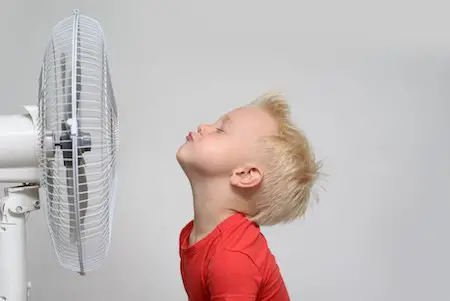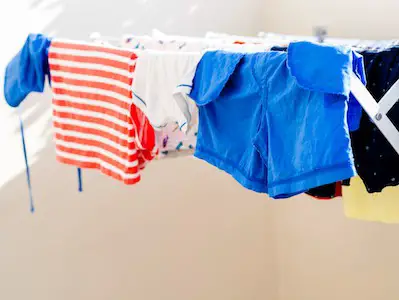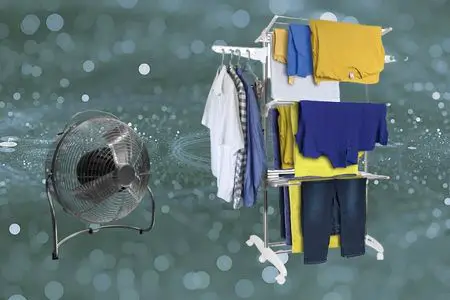Laundry is a tedious task for many people. It can be a headache for many people. Most people even find it more demanding and challenging when they are faced with the issue of drying their clothes under unfavorable weather conditions like the rainy season.
In unfavorable weather conditions such as when it is raining, it may not be a good idea to spread your clothes outdoors. Your clothes will not get dry in such weather conditions, and strong wind might even blow dirt on the clothes.
In such a condition, you have to keep your clothes safe and dry indoors. However, will your clothes get dry when you keep them indoors? This has made many ask the question “can I use my fan to dry my clothes?”

Fortunately, you can use a fan to dry your clothes. People have been doing this for years, and it comes in handy during the rainy season.
The phenomenon behind the drying of clothes is very simple. Your clothes get dry through the process of evaporation. When a wet cloth is surrounded by dry air, the air will absorb the water from the wet cloth.
Fortunately, fans make the process of absorbing the water from the wet clothes much faster, as the air in motion disperses water molecules away from the cloth in the form of water vapor. Fans have come to the rescue of many people during the rainy season, especially those who have to wear different outfits or a uniform to work every day of the week.
However, there is a more efficient way of doing this; that is if you want to achieve a better result. In this guide, we will show you how you can use a fan to dry your clothes successfully. We will also show you some techniques that you can use to achieve this goal more efficiently and faster.
Read on to see our recommended techniques for drying your clothes faster with a fan.
What Is Evaporation, How Does It Work, and What Are the Factors that Affect It?
Many people know the definition of evaporation, well, except you missed Chemistry class while in school. In a very simple form, evaporation is the process of turning liquid into vapor or gases. This is something we see every day, especially in the kitchen.
When cooking or boiling water, the vapor you see is water that is being converted, and the conversion process is known as evaporation.

When you spread your wet clothes outdoors, the process that takes place for that cloth to dry is evaporation. The sun generates enough heat and dry air around the cloth that causes the water on it to evaporate.
Now, when you spread your clothes indoors, the fan does a similar thing. Some vital factors such as temperature, airflow rate, humidity, and more also affect evaporation. In this section, we will be analyzing how these factors contribute to drying your clothes.
Temperature
One of the key factors affecting evaporation is temperature. The rate at which the water on the clothes evaporates into gasses or vapor is determined by the temperature around the clothes. If the temperature rises, so will the rate of evaporation. This is why our clothes tend to dry faster on sunny days.
When the sun is out, especially when it is very hot, there would be a significant increase in temperature. The sun generates a lot of heat, which helps to break the bonds holding water molecules in fabric together. The hotter the sun, the faster these molecules break, and the faster your cloth dries.
When the heat from the sun hits your clothes, it releases thermal energy that results in the random bumping of molecules. Some of them will have more thermal energy than others.
The water molecules with more energy, especially those closer to the surface of the cloth, will break the molecular bonds and vanish into the air as vapor. They will continue to get released into the air until every water molecule leaves the fabric.
This is practically how the sun dries our clothes. It is a gradual process and it repeats until there are no more water molecules left on the cloth. The heat from the sun energizes the molecules of water on your cloth and it gets dry, as the water vaporizes.
The Rate of Airflow
Airflow rate is another vital factor that affects evaporation. This factor is crucial to understanding how a fan can dry your clothes.
If the air in the environment you spread your cloth is static, most of the water molecules dripping off your cloth will settle close to the edge of the cloth, as the air is not moving in any direction to blow the vapor away. While evaporation will still be taking place, it will take a very long time for the cloth to dry, as the diffusion process will be slow.
The aftermath of this is that the water molecules close to the edge of the cloth bump into each other due to the saturation of the air and can no longer hold moisture, resulting in condensation. This only increases the amount of time it will take the cloth to dry, as the vapor settles down on the cloth and evaporates at a slow pace.

On the other hand, if the rate of airflow in the environment is high, the cloth will dry much faster. If you spread your clothes in an environment with air in motion, the vaporized water will leave the clothes much faster. They will not have any chance to condense and settle on the surface of the cloth.
Even without heat from sunlight, this approach can dry your cloth much faster, thanks to the air in motion. Hence, this is what a fan does.
A fan ensures the air around your cloth is not static. It would blow air past the wet clothes, cause the air around your cloth to move, and hasten up the drying process of your cloth. The constant motion of the air will give no room for vaporized water to condense and settle on the surface of the cloth. The fan will displace the water vapor much faster, making it easy for more air to diffuse vapor.
The higher the speed of the fan, the more the airflow rate. The more the airflow rate, the faster the evaporation process. When the speed of the fan is high, it will continue blowing air with lower humidity past the cloth, and this will make it dry faster. This is why your clothes tend to dry faster in windy and dry conditions than in windy and wet conditions.
The fan will create a dry environment to speed up the evaporation process, ensuring you have dry clothes during the rainy season when you cannot spread your clothes outdoors.
Humidity
The amount of water vapor in the air is referred to as humidity. Whenever you spread a wet cloth, water molecules evaporate from the cloth and move into the air. The water molecules that move into the air interact and also mix with liquid in the air.
If the rate at which water molecules are interacting with the liquid in the air is faster than the rate at which they leave your cloth, the air will be moister, and this will create an unfavorable environment for your cloth to dry. It will make it difficult for your cloth to dry.
Your cloth can only dry faster when the humidity in the environment is lesser. When the humidity in the environment is lesser, water molecules on the clothes will evaporate at a very fast rate, creating a better environment for your cloth to dry. Therefore, the lesser the humidity, the faster your cloth will dry.
Is a Fan an Ideal Way to Dry Clothes?
Many are wondering if it is a good idea to dry their clothes with a fan. Some people believe using other means, apart from the sun’s heat, to dry clothes is not good. Well, that is not true. Using a fan is a great, acceptable way of drying your clothes, especially in unfavorable weather conditions. Sometimes, you will not have any other option than to use a fan to dry your clothes.
When it comes to drying your clothes, it is crucial to note that all the aforementioned factors need to work together for you to achieve your goal faster.

If they work independently, it might still take a lot of time for your clothes to dry. Hence, while the fastest way to dry your clothes is to expose them to sunlight by spreading them outdoors, humidity and airflow also play a key role.
Nevertheless, this might result in the question “what is the best way of drying wet clothes?” This is an essential question that cannot be understated. Exposing your clothes to direct sunlight will dry them much faster. This is a very effective and common way of drying clothes. However, this method of drying clothes comes with a caveat.
There are some downsides to exposing your clothes to sunlight for an extended period. When you expose your clothes to sunlight recurrently, your fabric will begin to lose its color. Over time, your fabric will start fading out, which is something you do not want. While some fabrics can withstand this exposure for a long time before fading out, others will fade out much more quickly than expected.
If you do not want this to happen to your clothes and you want them to retain their beautiful colors for a long time, you should limit the way you expose them to sunlight. Because you do not want your clothes to lose their color and fade out, the best alternative you have to dry your clothes is using a fan. Using a fan to dry your clothes is one of the best alternatives to exposing your clothes to sunlight.
This method is effective, and it works very fast. It helps to retain the color and quality of clothes. Regardless of how many times you use a fan to dry your clothes, they will never experience discoloration or fading.
Fortunately, you do not have to use your standing or ceiling fan to dry your clothes anymore. There are fans designed specially to dry laundry. These fans provide the right amount of airflow to dry your clothes. They also help to create the perfect humidity to enable your clothes much faster.
There are many options to choose from on the market. These fans are electric-powered and most of them are highly energy-efficient, which means you will not experience a hike in your electricity bill for drying your clothes with a fan. Interestingly, if you cannot afford any of these special fans, you can use your normal standing fan. You can use a hanger and electric fan to dry your clothes at home.
Caution
There are a couple of things you need to consider and keep in mind when using a fan to dry your clothes. First, you should only use this method of drying clothes in an environment with good ventilation.
When using a fan to dry your clothes, you want to make sure the process takes place in a spacious environment. In addition to having good ventilation, the place should have enough space.
As we mentioned earlier, humidity is one of the most important keys to evaporation. It is a crucial factor that contributes to the rate at which your clothes dry. For instance, if you shut the doors and windows of your laundry room and try to dry your clothes, you will encounter the issue of static air. When the air in the environment is static, it would result in dampness and slow down the rate at which your clothes dry. The saturated environment will not allow your clothes to dry as fast as they ought to.
Furthermore, you should try to avoid using a fan to dry your clothes on a large scale. A couple of skirts, trousers, blouses, and shirts should be fine. You can also use it to dry fabrics made from light materials such as cotton and nylon. Using a fan to dry thick fabrics is not a good idea.
Attempting to use a fan to dry thicker fabric such as blankets might not end up as expected. After the process, you might have to deal with issues such as the dampness that accompanies it. Hence, if you have such thick materials, you should consider spreading them outdoors for wind, and probably sun, to do the needful.
Trying to use a fan to dry a blanket might also be detrimental to the fan. The fan would have to do over 5 times the amount of work required to dry fabrics made from light materials.
This means your fan would have to overwork itself, which might cause it to stop working or reduce its durability, and we are sure you do not want this to happen. Hence, you should only use a fan to dry light clothes, possibly your everyday clothes, office clothes, baby clothes, uniforms, and more.
The lighter the material used to make the clothes, the less time it would take to dry, and the less work your fan would have to do.
Another thing you should avoid is the temptation of placing your clothes on the fan directly. Whatever you are doing, your safety should be your top priority. Fans are powered by electricity, which means they have electrical parts. As you already know, electricity and water are the worst of enemies, and they never interact well. Hence, you should avoid anything that would result in electric shock.
You should not place your clothes onto the fan directly, since the cloth will be wet and this can result in electric shock. Even if you are able to avoid electrocution, placing a wet cloth directly on the fan can cause it to malfunction, and you do not want to spend your hard-earned money purchasing something you already have. To prevent this issue, you should place your clothes in front of the fan rather than on top of it.
Before you start the drying process, you should shake the clothes properly to drain as much water on them as possible. This will help to make the clothes dry much faster. For your safety and that of your household, you should make sure the floor of your laundry room is dry before using the fan to dry your clothes. Your hand should also be dry before plugin it into the power outlet.
You should avoid using fans with electrical faults or naked wires.
Final Thoughts
One of the major challenges that come with unfavorable weather conditions such as rainy seasons is drying our clothes. After washing over the weekend, there might be no sun to dry up the clothes. Even when there is sun, it is not the best method of drying clothes, as it could affect the color of the cloth and cause it to fade out.
Fortunately, you can use a fan to dry your clothes. You can dry your clothes using a fan via the process of evaporation. This is pretty interesting, as your clothes will dry perfectly even in the absence of sunlight. However, the process of evaporation depends on three major factors, which are temperature, airflow rate, and humidity.
If you want your clothes to last for a long time and retain their beautiful colors, you should reduce their exposure to direct sunlight. You should dry them with a fan whenever you can. Exposing your clothes excessively to sunlight can cause them to fade out.
When drying your clothes with a fan, you should also make sure you do it in a spacious place. The place should have good ventilation and it should be spacious enough.
You should always have the safety tips listed above in mind whenever you are drying your clothes with a fan. Avoid putting the cloth on the fan directly. You should place the clothes in front of the fan instead of placing them on top of it. If you have clothes made from thicker materials, you should consider spreading them outdoors. Remember, the higher the speed of the fan, the faster your clothes will dry.



